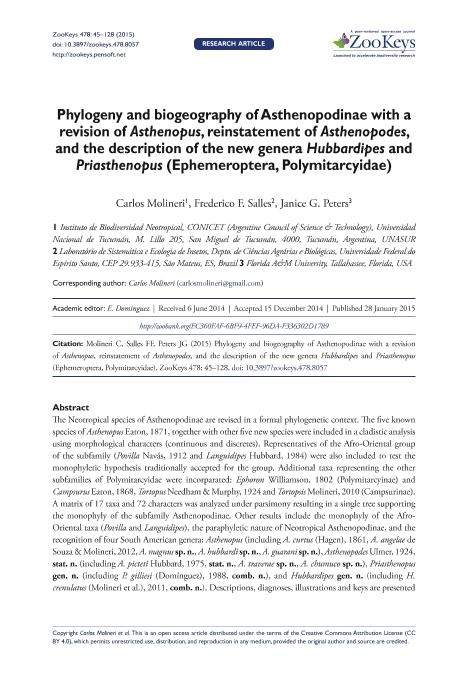Mostrar el registro sencillo del ítem
dc.contributor.author
Molineri, Carlos

dc.contributor.author
Salles, Frederico
dc.contributor.author
Peters, Janice G.
dc.date.available
2017-02-10T18:14:35Z
dc.date.issued
2015-01
dc.identifier.citation
Molineri, Carlos; Salles, Frederico; Peters, Janice G.; Phylogeny and biogeography of Asthenopodinae with a revision of Asthenopus, reinstatement of Asthenopodes, and the description of the new genera Hubbardipes and Priasthenopus (Ephemeroptera, Polymitarcyidae); Pensoft Publishers; Zookeys; 478; 1-2015; 45-128
dc.identifier.issn
1313-2989
dc.identifier.uri
http://hdl.handle.net/11336/12859
dc.description.abstract
The Neotropical species of Asthenopodinae are revised in a formal phylogenetic context. The five known species of Asthenopus Eaton, 1871, together with other five new species were included in a cladistic analysis using morphological characters (continuous and discretes). Representatives of the Afro-Oriental group of the subfamily (Povilla Navás, 1912 and Languidipes Hubbard, 1984) were also included to test the monophyletic hypothesis traditionally accepted for the group. Additional taxa representing the other subfamilies of Polymitarcyidae were incorparated: Ephoron Williamson, 1802 (Polymitarcyinae) and Campsurus Eaton, 1868, Tortopus Needham & Murphy, 1924 and Tortopsis Molineri, 2010 (Campsurinae). A matrix of 17 taxa and 72 characters was analyzed under parsimony resulting in a single tree supporting the monophyly of the subfamily Asthenopodinae. Other results include the monophyly of the Afro-Oriental taxa (Povilla and Languidipes), the paraphyletic nature of Neotropical Asthenopodinae, and the recognition of four South American genera: Asthenopus (including A. curtus (Hagen), 1861, A. angelae de Souza & Molineri, 2012, A. magnus sp. n., A. hubbardi sp. n., A. guarani sp. n.), Asthenopodes Ulmer, 1924, stat. n. (including A. picteti Hubbard, 1975, stat. n., A. traverae sp. n., A. chumuco sp. n.), Priasthenopus gen. n. (including P. gilliesi (Domínguez), 1988, comb. n.), and Hubbardipes gen. n. (including H. crenulatus (Molineri et al.), 2011, comb. n.). Descriptions, diagnoses, illustrations and keys are presented for all Neotropical taxa of Asthenopodinae (adults of both sexes, eggs and nymphs). Additionally a key to the subfamilies and genera of Polymitarcyidae is included. A quantitative biogeographic analysis of vicariance is presented and discussed through the study of the “taxon history” of the group.
dc.description.abstract
Se revisan las especies neotropicales de Asthenopodinae en un contexto filogenético. Las cinco especies de Asthenopus Eaton, 1871, junto con otras cinco nuevas especies, son analizadas cladísticamente a partir de caracteres morfológicos externos (continuos y discretos). También se incluyen representantes del grupo Afro-Oriental de la subfamilia (Povilla Navás, 1912 y Languidipes Hubbard, 1984) para comprobar la hipótesis de monofilia tradicionalmente aceptada para el grupo. Se incorporaron taxones adicionales representando las otras subfamilias de Polymitarcyidae: Ephoron Williamson, 1802 (Polymitarcyinae) y Campsurus Eaton, 1868, Tortopus Needham & Murphy, 1924 y Tortopsis Molineri, 2010 (Campsurinae). Se analizó bajo parsimonia una matriz de 17 taxa y 72 caracteres resultando un sólo árbol que apoya la monofilia de Asthenopodinae. Otros resultados incluyen la monofilia del grupo Afro-Oriental (Povilla y Languidipes), la naturaleza parafilética de los Asthenopodinae neotropicales, y el reconocimiento de cuatro géneros sudamericanos: Asthenopus (incluyendo a A. curtus (Hagen), 1861, A. angelae de Souza & Molineri, 2012, A. magnus sp. n., A. hubbardi sp. n., A. guarani sp. n.), Asthenopodes Ulmer, 1924, stat. n. (A. picteti Hubbard, 1975, stat. n., A. traverae sp. n., A. chumuco sp. n.), Priasthenopus gen. n. (P. gilliesi (Domínguez), 1988, comb. n.), y Hubbardipes gen. n. (H. crenulatus (Molineri et al.), 2011, comb. n.). Se presentan descripciones, diagnosis, ilustraciones y claves para todos los taxones neotropicales de Asthenopodinae (adultos de ambos sexos, huevos y ninfas). Adicionalmente se incluye una clave para subfamilias y géneros de Polymitarcyidae. Se presenta un análisis biogeográfico cuantitativo de vicarianza y se discute la historia particular del grupo.
dc.format
application/pdf
dc.language.iso
eng
dc.publisher
Pensoft Publishers

dc.rights
info:eu-repo/semantics/openAccess
dc.rights.uri
https://creativecommons.org/licenses/by-nc-sa/2.5/ar/
dc.subject
Ephemeroptera
dc.subject
Ephemeroidea
dc.subject
Fossoriae
dc.subject
Vicariance
dc.subject.classification
Zoología, Ornitología, Entomología, Etología

dc.subject.classification
Ciencias Biológicas

dc.subject.classification
CIENCIAS NATURALES Y EXACTAS

dc.title
Phylogeny and biogeography of Asthenopodinae with a revision of Asthenopus, reinstatement of Asthenopodes, and the description of the new genera Hubbardipes and Priasthenopus (Ephemeroptera, Polymitarcyidae)
dc.type
info:eu-repo/semantics/article
dc.type
info:ar-repo/semantics/artículo
dc.type
info:eu-repo/semantics/publishedVersion
dc.date.updated
2017-02-09T18:23:53Z
dc.identifier.eissn
1313-2970
dc.journal.volume
478
dc.journal.pagination
45-128
dc.journal.pais
Bulgaria

dc.journal.ciudad
Sofia
dc.description.fil
Fil: Molineri, Carlos. Consejo Nacional de Investigaciones Cientificas y Tecnicas. Centro Cientifico Tecnologico Tucuman. Instituto de Biodiversidad Neotropical; Argentina. Universidad Nacional de Tucumán; Argentina
dc.description.fil
Fil: Salles, Frederico. Universidade Federal Do Espirito Santo; Brasil
dc.description.fil
Fil: Peters, Janice G.. Florida Agricultural and Mechanical University; Argentina
dc.journal.title
Zookeys

dc.relation.alternativeid
info:eu-repo/semantics/altIdentifier/doi/https://doi.org/10.3897/zookeys.478.8057
dc.relation.alternativeid
info:eu-repo/semantics/altIdentifier/url/http://zookeys.pensoft.net/articles.php?id=4601
dc.relation.alternativeid
info:eu-repo/semantics/altIdentifier/url/https://www.ncbi.nlm.nih.gov/pmc/articles/PMC4319052/
Archivos asociados
